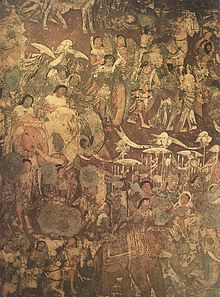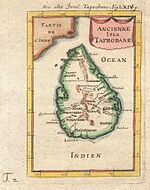Pre-Anuradhapura period
| Pre Anuradhapura period | |||
|---|---|---|---|
| 543 BC – 437 BC | |||
 A section of the mural from Ajanta Caves 17, depicting the "coming of Sinhala". | |||
| Monarch(s) | House of Vijaya
| ||
Chronology
| |||
| History of Sri Lanka | ||||||||||||||||
|---|---|---|---|---|---|---|---|---|---|---|---|---|---|---|---|---|
 | ||||||||||||||||
| Chronicles | ||||||||||||||||
| Periods | ||||||||||||||||
|
||||||||||||||||
| By Topic | ||||||||||||||||
The Pre-Anuradhapura period of Sri Lankan history begins with the gradual onset of historical records in the final centuries of the prehistoric period and ending in 437 BC. According to the Mahavamsa, the original inhabitants of Sri Lanka are the Yakshas and northern Naga tribes. Sinhalese history traditionally starts in 543 BC at the arrival of Prince Vijaya, a semi-legendary king who was banished from the Indian subcontinent with his 700 followers and is recorded in the Mahavamsa chronicle. This period was succeeded by the Anuradhapura period.
Overview
[edit]Periodization of Sri Lanka's history:
| Dates | Period | Period | Span (years) | Subperiod | Span (years) | Main government |
|---|---|---|---|---|---|---|
| 300,000 BP–~1000 BC | Prehistoric Sri Lanka | Stone Age | – | 300,000 | Unknown | |
| Bronze Age | – | |||||
| ~1000 BC–543 BC | Iron Age | – | 457 | |||
| 543 BC–437 BC | Ancient Sri Lanka | Pre-Anuradhapura | – | 106 | Monarchy | |
| 437 BC–463 AD | Anuradhapura | 1454 | Early Anuradhapura | 900 | ||
| 463–691 | Middle Anuradhapura | 228 | ||||
| 691–1017 | Post-classical Sri Lanka | Late Anuradhapura | 326 | |||
| 1017–1070 | Polonnaruwa | 215 | Chola conquest | 53 | ||
| 1055–1232 | 177 | |||||
| 1232–1341 | Transitional | 365 | Dambadeniya | 109 | ||
| 1341–1412 | Gampola | 71 | ||||
| 1412–1592 | Early Modern Sri Lanka | Kotte | 180 | |||
| 1592–1739 | Kandyan | 223 | 147 | |||
| 1739–1815 | Nayakkar | 76 | ||||
| 1815–1833 | Modern Sri Lanka | British Ceylon | 133 | Post-Kandyan | 18 | Colonial monarchy |
| 1833–1948 | 115 | |||||
| 1948–1972 | Contemporary Sri Lanka | Sri Lanka since 1948 | 77 | Dominion | 24 | Constitutional monarchy |
| 1972–present | Republic | 53 | Unitary semi-presidential constitutional republic |
Background
[edit]According to several sources, the Naga people were one of the groups that lived in coastal regions of Sri Lanka and Tamil country before the arrival of Aryans in Lanka and Dravidians in Tamil country. Some recorded naga settlements in Sri Lanka were Kelaniya and the modern-day Jaffna peninsula. One of the evidence that can be used to prove that point is the Jaffna peninsula being called Nagadeepa in pali or Nakadiva in early Sinhala. The Naga people probably followed a set of beliefs unique to them just like other indigenous communities worldwide. We can speculate that part of their traditions included the veneration of serpents. And they may have started to follow the teachings in the Vedic scriptures and Buddhism (Probably non-denominational Buddhism that existed before the second buddhist council) after they came into contact with Aryans. They were later integrated into the dominant cultures of the areas where they lived, which were Tamil culture in Tamil country and Sinhala culture in Sri Lanka
Political History
[edit]The Kingdom of Tambapanni existed from 543 BC to 505 BC. According to Mahavamsa, the legendary Prince Vijaya and seven hundred of his followers came to Sri Lanka after being expelled from Sinhapura in India. Vijaya is said to have landed on the island on the day of Gautama Buddha's death, although it is suspected that the dates have coincided purposefully during writing.[1] Before Parinirvana, the Buddha had asked the deities to protect the island because Buddhism will flourish and continue to exist in Sri Lanka. Prince Vijaya established the Kingdom of Tambapanni. He married a local Yakkhini named Kuveni, and their children gave rise to the Pulinda race (identified with the Vedda people). Vijaya also married a princess of the Pandu kingdom (identified with Pandyan kingdom) but did not have any children with her. His followers also married maidens sent by the Pandu king, and their descendants gave rise to the Sinhalese race.[2][3]
Historiography
[edit]The Pali chronicles, the Dipavamsa, Mahavamsa, Thupavamsa[4] and the Culavamsa as well as a large collection of stone inscriptions,[5] the Indian Epigraphical records, the Burmese versions of the chronicles etc., provide an exceptional record for the history of Sri Lanka from about the sixth century BC.
The Mahavamsa, written around 400 AD, using the Dipavamsa, the Attakatha and other written sources available, it correlates well with Indian histories of the period. Emperor Asoka's reign is recorded in the Mahavamsa. The Mahavamsa account of the period prior to Asoka's coronation, (218 years after the Buddha's death) seems to be part legend. The account of the Mahavamsa, a Pali text written largely from the Sinhalese perspective, has mythological beginnings but becomes historical from the third century BC, with the arrival of Buddhism under Devanampiya Tissa of Sri Lanka. Epigraphic sources also appear with the presence of Buddhism, from about the third century BC. The earliest historiographic literature, such as the Mahavamsa, dates to the sixth century AD. The entire ancient period of history written in the Mahavamsa is dominated by the Anuradhapura Kingdom. The medieval period in Sri Lanka is taken to begin with the fall of the Anuradhapura Kingdom in AD 1017.
Legacy
[edit]Within Sri Lanka, the legend of Vijaya is often treated as a factual account of a historical event. However, multiple scholars consider the legend of dubious historicity. Satchi Ponnambalam called it a "pure flight of fantasy".[6] According to Gavin Thomas, the narration of historical events in Mahavamsa and its continuation Culavamsa is "at best questionably-biased, and at worst totally imaginary", aimed at establishing the royal lineage of the Sinhalese and the Buddhist credentials of the island.[7] According to H.W. Codrington, Vijaya is probably a composite character, and the legend is aimed at connecting the early history of Sri Lanka with that of Buddha.[8]
Monarchs
[edit]
(543 BC–505 BC)
The House of Vijaya produced four monarchs and two regents who ruled during this period.
| # | Name | Era | House | Reign | Duration | |
|---|---|---|---|---|---|---|
| From | To | (years, months, days) | ||||
| 1 | Vijaya | Tambapanni | Vijaya | 543 BC | 505 BC | 38 Years |
| - | Upatissa | 505 BC | 504 BC | 1 Year | ||
| 2 | Panduvasdeva | 504 BC | 474 BC | 30 Years | ||
| 3 | Abhaya | 474 BC | 454 BC | 20 Years | ||
| - | Tissa | 454 BC | 437 BC | 17 Years | ||
Timeline
[edit]Events
[edit]- 543 BC: The Kingdom of Tambapanni is established by Prince Vijaya
In popular culture
[edit]- Vijaya Kuweni, 2012 Sinhala epic biographical history film.
See also
[edit]References
[edit]- ^ Guruge, Ananda W. P. (1995). අපේ සංස්කෘතික උරුමය (in Sinhala). Sri Lanka: මධ්යම සංස්කෘතික අරමුදල. p. 23. ISBN 978-955-613-292-2.
- ^ John M. Senaveratna (1997). The story of the Sinhalese from the most ancient times up to the end of "the Mahavansa" or Great dynasty. Asian Educational Services. pp. 7–22. ISBN 978-81-206-1271-6.
- ^ Mudaliyar C. Rasanayagam (1984). Ancient Jaffna. Asian Educational Services. ISBN 9788120602106.
- ^ Geiger-Bode translation of the Mahavamsa. lakdiva.org
- ^ Paranavithana Epigraphics Zeylanica
- ^ Bruce Kapferer, ed. (2012). Legends of People, Myths of State. Violence, Intolerance, and Political Culture in Sri Lanka and Australia. Berghahn. pp. 34–37. ISBN 978-0-85745-436-2.
- ^ Gavin Thomas (2009). The Rough Guide to Sri Lanka. Penguin. p. 415. ISBN 9781405385169.
- ^ Humphry William Codrington (1926). "The beginnings; and the Conversion to Buddhism". A short history of Lanka. Macmillan. Retrieved 20 October 2015.
Bibliography
[edit]- Kāmboja, Jiyālāla (1981). Ancient Kamboja, People and the Country. Isṭarana Buka Liṅkarsa. OCLC 14053560.
Further reading
[edit]- Mittal, J. P. (2006). "Other dynasties". History of Ancient India: From 4250 BC to 637 AD. Vol. 2 of History of Ancient India: A New Version. Atlantic Publishers & Distributors. ISBN 81-269-0616-2.

